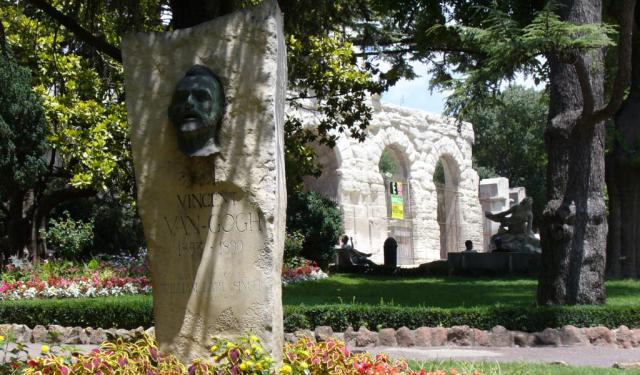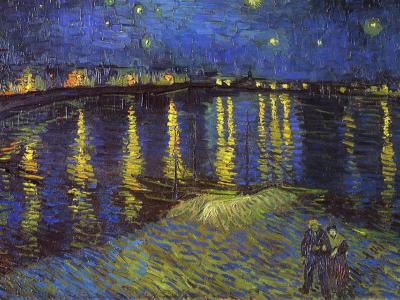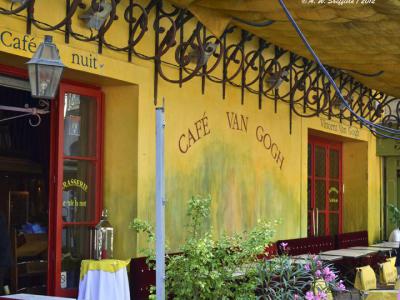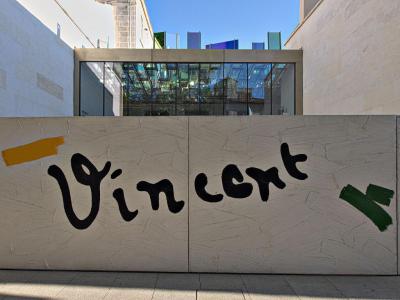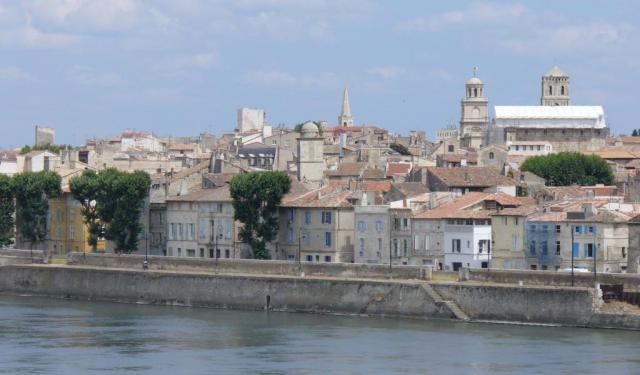Audio Guide: Vincent van Gogh Walking Tour (Self Guided), Arles
"There's no place quite like it for painters. It's so beautiful and peaceful..." These words, reportedly attributed to Vincent van Gogh, emphasize the beauty and exceptional qualities of Arles with which the renowned Dutch painter had a special connection.
Vincent van Gogh moved to this town in 1888, after having worked in Paris for two years. In the late 19th century, Arles proved to be a sanctuary for many artists, writers, and notable figures – a place where creativity thrived and inspiration was abundant. "The sunflowers in Arles are a wonder to behold,” van Gogh admittedly used to say. "I could paint them forever."
Looking for a softer light and brighter colors, he found them in the south of France. The painter spent here a year, during which he developed his own, unique style and brushwork. The time in Arles had a profound impact on Van Gogh's art. He produced an incredible 187 paintings and drawings, captivated by the local landscapes, architecture, and people, often finding inspiration in the countryside and the vibrant streets of the city.
Some of his most celebrated works here include "The Bedroom" and "The Yellow House", created at 2 Place Lamartine, the residence Van Gogh occupied from September 1888 to May 1889. Unfortunately, the original Yellow House was destroyed during World War II, but a reconstructed version stands today in its place.
"The Café Terrace at Night" is yet another famous work by Van Gogh completed in Arles. This painting depicts a cafe located in Place du Forum which today bears his name.
There are many other locations related to the life and work of Van Gogh in Arles that could still be found. Alyscamps, the ancient Roman necropolis, is one of them.
Beside intense productivity, Van Gogh's association with Arles was marked by personal struggles, too. He experienced mental health challenges, culminating in the famous incident where he cut off part of his ear. Despite the difficulties he faced, Van Gogh regarded Arles as a precious gem, "where color and light dance together in perfect harmony."
Indeed, the timeless charms of Arles possess enduring power to produce the image of eternal beauty and fascination. For a deeper understanding of Van Gogh's artistic journey in this city, take this self-guided walk.
Vincent van Gogh moved to this town in 1888, after having worked in Paris for two years. In the late 19th century, Arles proved to be a sanctuary for many artists, writers, and notable figures – a place where creativity thrived and inspiration was abundant. "The sunflowers in Arles are a wonder to behold,” van Gogh admittedly used to say. "I could paint them forever."
Looking for a softer light and brighter colors, he found them in the south of France. The painter spent here a year, during which he developed his own, unique style and brushwork. The time in Arles had a profound impact on Van Gogh's art. He produced an incredible 187 paintings and drawings, captivated by the local landscapes, architecture, and people, often finding inspiration in the countryside and the vibrant streets of the city.
Some of his most celebrated works here include "The Bedroom" and "The Yellow House", created at 2 Place Lamartine, the residence Van Gogh occupied from September 1888 to May 1889. Unfortunately, the original Yellow House was destroyed during World War II, but a reconstructed version stands today in its place.
"The Café Terrace at Night" is yet another famous work by Van Gogh completed in Arles. This painting depicts a cafe located in Place du Forum which today bears his name.
There are many other locations related to the life and work of Van Gogh in Arles that could still be found. Alyscamps, the ancient Roman necropolis, is one of them.
Beside intense productivity, Van Gogh's association with Arles was marked by personal struggles, too. He experienced mental health challenges, culminating in the famous incident where he cut off part of his ear. Despite the difficulties he faced, Van Gogh regarded Arles as a precious gem, "where color and light dance together in perfect harmony."
Indeed, the timeless charms of Arles possess enduring power to produce the image of eternal beauty and fascination. For a deeper understanding of Van Gogh's artistic journey in this city, take this self-guided walk.
How it works: Download the app "GPSmyCity: Walks in 1K+ Cities" from Apple App Store or Google Play Store to your mobile phone or tablet. The app turns your mobile device into a personal tour guide and its built-in GPS navigation functions guide you from one tour stop to next. The app works offline, so no data plan is needed when traveling abroad.
Vincent van Gogh Walking Tour Map
Guide Name: Vincent van Gogh Walking Tour
Guide Location: France » Arles (See other walking tours in Arles)
Guide Type: Self-guided Walking Tour (Sightseeing)
# of Attractions: 6
Tour Duration: 1 Hour(s)
Travel Distance: 2.1 Km or 1.3 Miles
Author: DanaOffice
Sight(s) Featured in This Guide:
Guide Location: France » Arles (See other walking tours in Arles)
Guide Type: Self-guided Walking Tour (Sightseeing)
# of Attractions: 6
Tour Duration: 1 Hour(s)
Travel Distance: 2.1 Km or 1.3 Miles
Author: DanaOffice
Sight(s) Featured in This Guide:
- The Yellow House
- Starry Night over the Rhone
- Cafe Van Gogh
- Fondation Vincent van Gogh (Arles Vincent van Gogh Foundation)
- Espace Van Gogh
- Alyscamps
1) The Yellow House
The Yellow House is an iconic painting created by Vincent van Gogh. Painted in 1888, it depicts the right wing of 2 Place Lamartine in Arles, which served as van Gogh's residence for a period of time.
Van Gogh rented four rooms in the house on May 1, 1888, with the intention of using two large rooms on the ground floor as his workshop and kitchen. On the first floor, he occupied two smaller rooms that faced Place Lamartine. The window on the first floor, closest to the corner, and with both shutters open, belonged to van Gogh's guest room where his fellow artist Paul Gauguin lived for nine weeks starting from late October 1888. The following window, with partially closed shutters, belonged to van Gogh's own bedroom. The two smaller rooms at the back of the house were rented by van Gogh at a later time.
In the painting, van Gogh also indicated a nearby pink building, located on 28 Place Lamartine, which served as the restaurant where he frequently had his meals. This building was owned by Widow Venissac, who was not only van Gogh's landlady but also owned several of the other depicted buildings. To the right of the Yellow House, the Avenue Montmajour can be seen, leading to two railway bridges. Additionally, a ditch running along Avenue Montmajour is depicted, which served as the gas pipe that allowed van Gogh to install gas lighting in his workshop later on.
Although the actual Yellow House suffered heavy damage during World War II and was eventually destroyed, the location depicted in van Gogh's painting remains recognizable. The Yellow House holds immense historical and artistic significance, as it represents a pivotal period in van Gogh's life when he lived and worked alongside Gauguin, and it showcases his unique artistic style and use of vibrant colors.
Van Gogh rented four rooms in the house on May 1, 1888, with the intention of using two large rooms on the ground floor as his workshop and kitchen. On the first floor, he occupied two smaller rooms that faced Place Lamartine. The window on the first floor, closest to the corner, and with both shutters open, belonged to van Gogh's guest room where his fellow artist Paul Gauguin lived for nine weeks starting from late October 1888. The following window, with partially closed shutters, belonged to van Gogh's own bedroom. The two smaller rooms at the back of the house were rented by van Gogh at a later time.
In the painting, van Gogh also indicated a nearby pink building, located on 28 Place Lamartine, which served as the restaurant where he frequently had his meals. This building was owned by Widow Venissac, who was not only van Gogh's landlady but also owned several of the other depicted buildings. To the right of the Yellow House, the Avenue Montmajour can be seen, leading to two railway bridges. Additionally, a ditch running along Avenue Montmajour is depicted, which served as the gas pipe that allowed van Gogh to install gas lighting in his workshop later on.
Although the actual Yellow House suffered heavy damage during World War II and was eventually destroyed, the location depicted in van Gogh's painting remains recognizable. The Yellow House holds immense historical and artistic significance, as it represents a pivotal period in van Gogh's life when he lived and worked alongside Gauguin, and it showcases his unique artistic style and use of vibrant colors.
2) Starry Night over the Rhone
One of Vincent van Gogh's notable works, "Starry Night over the Rhône," holds a special place in art history. Before creating his renowned painting "Starry Night" in Saint-Rémy, van Gogh painted "Starry Night Over the Rhône" during his time in Arles. Van Gogh had a fondness for painting at night, and the clear skies of Provence provided him with the opportunity to indulge in this passion. However, the challenge for him was capturing the vivid colors he loved amidst the darkness. To overcome this, he reportedly devised clever solutions.
There are different accounts of how van Gogh managed to paint at night. Some suggest that he modified his straw hat, lining its brim with candles to provide additional light while he worked. However, attempting this technique ourselves would not be recommended. Another account mentions van Gogh writing to his brother about using a "gas jet," although the specifics of this method are unclear. Regardless of the exact means he employed, van Gogh was able to create his masterpieces under the enchanting starlight.
Today, visitors have the opportunity to stand in the very spot where Vincent van Gogh painted "Starry Night over the Rhône." The location is marked by one of the many metal easels set up by the city to offer guidance and context to visitors. These explanatory easels provide insight into the artist's process and help art enthusiasts appreciate the connection between the painting and its real-life setting.
By visiting the spot where van Gogh stood and taking in the view of the Rhône River under the starry sky, viewers can experience a unique connection to the artist and his work. Standing in that place, one can imagine the artist's passion for capturing the beauty of the night, the play of light on the water, and the ethereal glow of the stars above.
There are different accounts of how van Gogh managed to paint at night. Some suggest that he modified his straw hat, lining its brim with candles to provide additional light while he worked. However, attempting this technique ourselves would not be recommended. Another account mentions van Gogh writing to his brother about using a "gas jet," although the specifics of this method are unclear. Regardless of the exact means he employed, van Gogh was able to create his masterpieces under the enchanting starlight.
Today, visitors have the opportunity to stand in the very spot where Vincent van Gogh painted "Starry Night over the Rhône." The location is marked by one of the many metal easels set up by the city to offer guidance and context to visitors. These explanatory easels provide insight into the artist's process and help art enthusiasts appreciate the connection between the painting and its real-life setting.
By visiting the spot where van Gogh stood and taking in the view of the Rhône River under the starry sky, viewers can experience a unique connection to the artist and his work. Standing in that place, one can imagine the artist's passion for capturing the beauty of the night, the play of light on the water, and the ethereal glow of the stars above.
3) Cafe Van Gogh
Café Le Soir, holds a special place in art history, particularly due to its association with Vincent van Gogh. The café, currently named "Van Gogh," is situated in the Place du Forum, which has a rich historical significance dating back to the Middle Ages.
The Place du Forum has a dark past, having been the site of capital executions during medieval times. However, it gained artistic renown through van Gogh's iconic 1888 painting, "Café Terrace at Night." The painting depicts the nocturnal terrace of the café, which closely resembles Café Le Soir as it appears today. Interestingly, the café underwent renovations in the 1990s, during which it was repainted yellow to accentuate its resemblance to van Gogh's artwork. This choice aimed to recreate the same ambiance depicted in the painting, as it is likely that the café had a yellow appearance at night due to the lighting conditions of the time.
For those who appreciate art and history, Café Le Soir in Arles offers a unique opportunity to step into van Gogh's world by immersing oneself in the same setting that inspired the artist.
The Place du Forum has a dark past, having been the site of capital executions during medieval times. However, it gained artistic renown through van Gogh's iconic 1888 painting, "Café Terrace at Night." The painting depicts the nocturnal terrace of the café, which closely resembles Café Le Soir as it appears today. Interestingly, the café underwent renovations in the 1990s, during which it was repainted yellow to accentuate its resemblance to van Gogh's artwork. This choice aimed to recreate the same ambiance depicted in the painting, as it is likely that the café had a yellow appearance at night due to the lighting conditions of the time.
For those who appreciate art and history, Café Le Soir in Arles offers a unique opportunity to step into van Gogh's world by immersing oneself in the same setting that inspired the artist.
4) Fondation Vincent van Gogh (Arles Vincent van Gogh Foundation)
The Fondation Vincent van Gogh in Arles is a contemporary art center housed in a beautifully restored 15th-century hôtel particulier. Rather than having a permanent collection, the foundation mounts rotating exhibitions that always include at least one original Vincent van Gogh painting, alongside works by modern and contemporary artists deeply inspired by him.
Visitors can see pieces by Van Gogh drawn from major collections, as well as works by artists such as Yan Pei-Ming, Roni Horn, Alice Neel, Urs Fischer, and David Hockney. The foundation also highlights historical figures who influenced Van Gogh, like Jean-François Millet and Adolphe Monticelli.
Its exhibition spaces—spread across about 1,000 m²—include a main gallery, an atrium, and the former rooms of a 19th-century bank director. On the top floor, a terrace offers panoramic views of Arles, the Rhône, and the ruined abbey of Montmajour—landscapes that were very dear to Van Gogh.
Recent and past shows have ranged from the “Studio of the South” residency featuring contemporary artists and Van Gogh’s spirit of artistic collaboration to thematic exhibitions like “The High Yellow Note”, exploring emotional and formal limits in art.
Visitors can see pieces by Van Gogh drawn from major collections, as well as works by artists such as Yan Pei-Ming, Roni Horn, Alice Neel, Urs Fischer, and David Hockney. The foundation also highlights historical figures who influenced Van Gogh, like Jean-François Millet and Adolphe Monticelli.
Its exhibition spaces—spread across about 1,000 m²—include a main gallery, an atrium, and the former rooms of a 19th-century bank director. On the top floor, a terrace offers panoramic views of Arles, the Rhône, and the ruined abbey of Montmajour—landscapes that were very dear to Van Gogh.
Recent and past shows have ranged from the “Studio of the South” residency featuring contemporary artists and Van Gogh’s spirit of artistic collaboration to thematic exhibitions like “The High Yellow Note”, exploring emotional and formal limits in art.
5) Espace Van Gogh
Espace Van Gogh holds historical significance as the former main hospital of the city. Dating back to the sixteenth century, the building served as Arles' primary medical institution until the twentieth century. However, its fame is largely associated with the time Vincent van Gogh spent here after the infamous incident of cutting off his left earlobe in December 1888.
The courtyard of Espace Van Gogh has been meticulously landscaped to resemble van Gogh's renowned painting, "The Courtyard of the Hospital." This artistic recreation adds to the allure of the site, providing visitors with a visual connection to van Gogh's artistic interpretation.
On 23 December 1888, Vincent van Gogh was admitted to the hospital in Arles following the episode of self-mutilation. Recognizing the need for specialized psychiatric care, Dr. Rey advocated for Vincent's transfer to an asylum in Marseille or Aix-en-Provence. The hospital in Arles primarily treated his physical injuries and was ill-equipped to address his mental health issues. However, in a surprising turn of events, Vincent's condition improved significantly in early January 1889, and he was allowed to return home for short periods of time. Feeling better, he resumed his passion for painting, creating artworks such as a portrait of Dr. Rey, which he presented as a memento to the doctor.
Unfortunately, Vincent suffered another bout of mental instability within a month, firmly believing he had been poisoned. He was readmitted to the hospital on 7 February and placed in isolation once again. Vincent remained in the hospital until early May, experiencing periods of lucidity that allowed him to paint outdoors. These artistic endeavors resulted in numerous landscapes and notable works such as "Ward in the Hospital" and "The Courtyard of the Hospital." On occasion, Vincent was granted permission to venture into town, particularly when his friend Paul Signac came to visit.
Today, the complex has been repurposed and houses the town library, exhibition spaces, souvenir shops, and a café. It offers a multifaceted experience where visitors can explore the rich history of the building while immersing themselves in various cultural activities.
The courtyard of Espace Van Gogh has been meticulously landscaped to resemble van Gogh's renowned painting, "The Courtyard of the Hospital." This artistic recreation adds to the allure of the site, providing visitors with a visual connection to van Gogh's artistic interpretation.
On 23 December 1888, Vincent van Gogh was admitted to the hospital in Arles following the episode of self-mutilation. Recognizing the need for specialized psychiatric care, Dr. Rey advocated for Vincent's transfer to an asylum in Marseille or Aix-en-Provence. The hospital in Arles primarily treated his physical injuries and was ill-equipped to address his mental health issues. However, in a surprising turn of events, Vincent's condition improved significantly in early January 1889, and he was allowed to return home for short periods of time. Feeling better, he resumed his passion for painting, creating artworks such as a portrait of Dr. Rey, which he presented as a memento to the doctor.
Unfortunately, Vincent suffered another bout of mental instability within a month, firmly believing he had been poisoned. He was readmitted to the hospital on 7 February and placed in isolation once again. Vincent remained in the hospital until early May, experiencing periods of lucidity that allowed him to paint outdoors. These artistic endeavors resulted in numerous landscapes and notable works such as "Ward in the Hospital" and "The Courtyard of the Hospital." On occasion, Vincent was granted permission to venture into town, particularly when his friend Paul Signac came to visit.
Today, the complex has been repurposed and houses the town library, exhibition spaces, souvenir shops, and a café. It offers a multifaceted experience where visitors can explore the rich history of the building while immersing themselves in various cultural activities.
6) Alyscamps
The Alyscamps, located just outside the old town of Arles, is a Roman necropolis and one of the most renowned burial grounds of the ancient world. Its name, Aliscamps, derived from the Provençal Occitan word, and the Latin Elisii Campi, translates to "Elysian Fields" or, in French, Champs-Élysées. This necropolis held great fame during the Middle Ages and found mention in literary works such as Ariosto's Orlando Furioso and Dante's Inferno.
During Roman times, cities typically prohibited burials within their walls. As a result, roads leading outside the city often featured tombs and mausoleums. The Alyscamps served as Arles' primary burial ground for approximately 1,500 years. Situated along the final stretch of the Aurelian Way, leading to the city gates, it became the resting place for affluent citizens. The memorials within the Alyscamps ranged from simple sarcophagi to elaborate monuments, reflecting the social status of the deceased. This historical significance led to the classification of the Alyscamps as a UNESCO World Heritage Site in 1981, as part of the Arles, Roman, and Romanesque Monuments group.
Vincent van Gogh, the famous Dutch painter, depicted the Alyscamps in four of his paintings during October 1888. This period coincided with Paul Gauguin's stay at the Yellow House in Arles. One of the paintings, titled "Les Alyscamps" or "Leaf Fall," adorned Gauguin's room. In a letter to his brother Theo, Vincent described one of the paintings:
"I think that you'd like the leaf-fall that I've done. It's lilac poplar trunks cut by the frame where the leaves begin. These tree-trunks, like pillars, line an avenue where old Roman tombs colored lilac-blue are lined up to right and left. Now the ground is covered as if by a carpet with a thick layer of orange and yellow leaves - fallen. Some are still falling, like snowflakes. And in the avenue dark figurines of lovers. The top of the painting is a very green meadow and no sky, or almost none."
Van Gogh's paintings capture the essence of the Alyscamps, depicting the rows of poplar trees with their trunks reaching skyward, framed by falling leaves. The lilac-blue Roman tombs line the avenue, while the ground is blanketed in a vibrant carpet of orange and yellow leaves. The presence of dark figurines of lovers evokes a sense of romance and mystery. The top of the painting portrays a lush green meadow, creating a vivid contrast with the absence of the sky.
During Roman times, cities typically prohibited burials within their walls. As a result, roads leading outside the city often featured tombs and mausoleums. The Alyscamps served as Arles' primary burial ground for approximately 1,500 years. Situated along the final stretch of the Aurelian Way, leading to the city gates, it became the resting place for affluent citizens. The memorials within the Alyscamps ranged from simple sarcophagi to elaborate monuments, reflecting the social status of the deceased. This historical significance led to the classification of the Alyscamps as a UNESCO World Heritage Site in 1981, as part of the Arles, Roman, and Romanesque Monuments group.
Vincent van Gogh, the famous Dutch painter, depicted the Alyscamps in four of his paintings during October 1888. This period coincided with Paul Gauguin's stay at the Yellow House in Arles. One of the paintings, titled "Les Alyscamps" or "Leaf Fall," adorned Gauguin's room. In a letter to his brother Theo, Vincent described one of the paintings:
"I think that you'd like the leaf-fall that I've done. It's lilac poplar trunks cut by the frame where the leaves begin. These tree-trunks, like pillars, line an avenue where old Roman tombs colored lilac-blue are lined up to right and left. Now the ground is covered as if by a carpet with a thick layer of orange and yellow leaves - fallen. Some are still falling, like snowflakes. And in the avenue dark figurines of lovers. The top of the painting is a very green meadow and no sky, or almost none."
Van Gogh's paintings capture the essence of the Alyscamps, depicting the rows of poplar trees with their trunks reaching skyward, framed by falling leaves. The lilac-blue Roman tombs line the avenue, while the ground is blanketed in a vibrant carpet of orange and yellow leaves. The presence of dark figurines of lovers evokes a sense of romance and mystery. The top of the painting portrays a lush green meadow, creating a vivid contrast with the absence of the sky.
Walking Tours in Arles, France
Create Your Own Walk in Arles
Creating your own self-guided walk in Arles is easy and fun. Choose the city attractions that you want to see and a walk route map will be created just for you. You can even set your hotel as the start point of the walk.
Arles Introduction Walking Tour
While living in Arles, Vincent van Gogh wrote to his brother Theo about the “soft and tender light” of the region. Although he called the town home for only 15 months, this brief period became the most productive of his career, yielding more than 300 works.
The town’s name comes from the ancient Ligurian and Celtic term Arelate, meaning “the dwelling by the marshes,” a nod to its... view more
Tour Duration: 1 Hour(s)
Travel Distance: 1.3 Km or 0.8 Miles
The town’s name comes from the ancient Ligurian and Celtic term Arelate, meaning “the dwelling by the marshes,” a nod to its... view more
Tour Duration: 1 Hour(s)
Travel Distance: 1.3 Km or 0.8 Miles
The Most Popular Cities
/ view all
